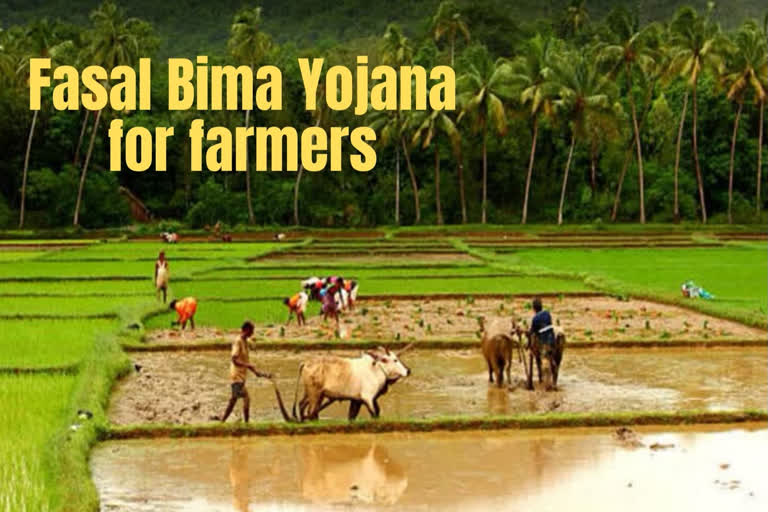Hyderabad: Recent changes to the crop insurance scheme may raise issues of sustainability - unless states agree to share a larger financial burden.
The Central Government recently approved major changes in the Pradhan Mantri Fasal Bima Yojana (PMFBY) making it optional for farmers with a view to plug loopholes in the farm insurance scheme.
Under the PMFBY, which was launched in February 2016 by Prime Minister Narendra Modi, it is mandatory for loanee farmers to take insurance cover under this scheme. Currently, 58 per cent of the total are loanee. Ever since the National Democratic Alliance government launched the much-discussed Pradhan Mantri Fasal Bima Yojana (PMFBY) in kharif 2016, it has seen numerous changes to make itself friendlier to the farmer.
Last fortnight (Feb 19, 2020) the Union Cabinet embarked on another such exercise by announcing a host of changes in PMFBY. There are two principal changes. The first is the decision to make the scheme voluntary for non-loanee farmers. Second, it imposes a limit on the premium subsidy to 30 per cent for unirrigated areas and crops and 25 per cent for irrigated areas and crops.
These two decisions together could have a big impact on the scheme and needs to be closely monitored in the coming seasons.
Making PMFBY voluntary for non-loanee farmers (it is already voluntary for loanee farmers) will, according to experts from leading insurance companies, lead to a drop in the number of farmers opting for the scheme since only those who perceive their risks as significantly high will enroll for the scheme.
In the short term, this output-provision could lead to a drop in the area covered under the scheme. In the short term, top government officials in the Ministry of Agriculture (central government) are seeing a 10-20 per cent drop in the area covered under PMFBY.
It is important to note that even with a great attention and promotion, the area under crop insurance has increased from 22 percent to 30 percent since its inception in 2016.
This apart, the total number of farmers enrolled under the scheme could also see a fall from kharif 2020. Already, data shows that between kharif 2016 and 2018, the total number of farmers enrolled for the scheme has fallen by almost 14 per cent from a high of 40.4 million to 34.80 million.
Officials say this fall in enrollment is largely due to the multitude of loan waivers announced by various state governments and mandatory Aadhaar-linkage weening away duplicate claimants.
As a consequence of fewer farmers enrolling for the scheme, the actuarial premium under PMFBY in the rabi season has steadily climbed to 12 per cent and 14 per cent for kharif season crops in the last few years.
Now, if even fewer farmers opt for the scheme, the actuarial premium is bound to go further up. It is here that the Centre’s limit on the subsidy will play a decisive role.
Under it, if the actuarial premium of any crop or area is more than 30 per cent under unirrigated conditions and 25 per cent in irrigated conditions, the Centre’s share of subsidy burden will be limited to that extent.
By way of illustration, suppose the actuarial premium of a crop comes to 40 per cent in an unirrigated area. In this, the farmer’s share is capped at 2 per cent and the remaining 38 per cent subsidy is shared equally between Centre and states in a 50:50 ratio. From the coming kharif season (2020), however, the farmer’s share in the actuarial premium will remain at 2 per cent, but the Centre on its part will bear the subsidy only up to 30 per cent, which means 14 per cent in the 50:50 ratio. The balance, which in this case comes to 24 per cent, will have to borne by the state if it wants to participate in the scheme.
Now, if any state does not want to share this additional burden, farmers there might remain outside the ambit of a credible insurance product and rely on the usual crop damage compensation under State Disaster Relief Fund (SDRF) in the event of crop loss. This could cause serious damage to the scheme’s health. (Some senior officials are wondering whether financially stressed states such as AP can really prepare themselves to meet the demands arising out of the recent changes brought out by the central government).
The compensation under SDRF in the event of a crop loss is far less than the scale of finance which is basis for claim settlement under PMFBY.
For agriculture, horticulture and annual plantation crops, compensation to small and marginal farmers is Rs 6,800 per hectare (of sown area) in non-irri- gated areas and Rs 13,500 per hectare in irrigated areas.
In the case of farmers owning more than 2 hectares of land, the assistance is limited to only 2 hectares. In contrast, the scale of finance in kharif 2018 in Gujarat’s Rajkot district (for example) was Rs 39,000 per hectare for castor, Rs 58,000 per hectare for irrigated cotton and Rs 42,000 per hectare are for groundnut.
So, in the absence of crop insurance, the farmers will get a much smaller amount of compensation under the current norms of SDRF.
A way out for the states to ensure that their share of subsidy remains low and farmers also get a good insurance product could be if they come out with their specific single-peril products which cover incidents such as hailstorm under PMFBY either with or without opting for the base cover.
The latest Cabinet decision has allowed these. Such a product in normal course will have a lower premium to cover customised risk. Whether this rejuvenates the PMFBY will need close monitoring in the coming years.
Read:| COVID-19: Telangana reports 7 fresh positive cases; state's tally stands at 13



